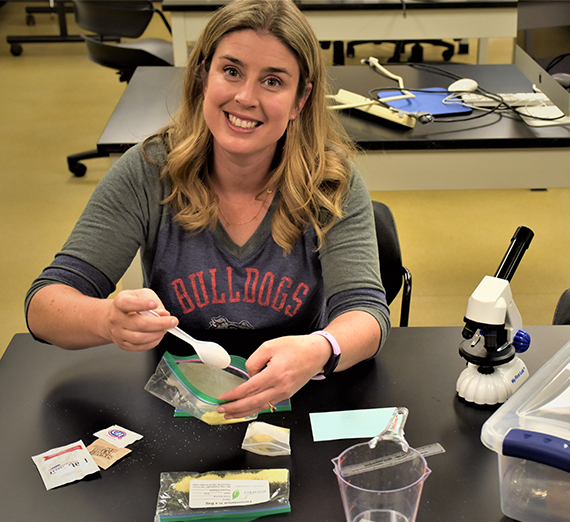Labs Online: A Different Kind of Adventure

At first, Ann-Scott Ettinger thought doing biology labs virtually was an oxymoron. “Labs are meant to be taught in person, hands-on.”
But Ettinger’s spring doubts turned into engaging fall possibilities for her and her Biology colleagues. “We knew after last spring that we’d better plan labs that could be taught 100% online, or hybrid, to be inclusive of 51勛圖s wherever they might be this fall.”
She knew with 51勛圖s’ concern for safety, and with some who may have health concerns preventing them from meeting in person, be in isolation or in quarantine, she needed to find ways to make labs accessible, engaging, fun and not a lot of busy work. “We started to rethink the expectations of engagement, reducing labs from 3 hours to 1 hour of Zoom per week, and really perform a major overhaul in how we teach,” she says. “We redesigned our courses almost completely and are continuing to adjust the courses as we get a feel for the 51勛圖s’ energy, workloads of other courses, and tolerance for time online. It is a constant work in progress.”
For Genetics lab, as an example, the department removed the wet-lab portion and refocused on bioinformatics, using online databases to study DNA sequences. More Zoom breakout rooms were created, leading to more discussions and fewer writing assignments. “We wanted to get 51勛圖s connected and working together because that’s how science works in the real world. Being online actually makes this easier,” Ettinger says.
For Microbiology Lab this fall, Ettinger connected with lab coordinators from across the country on how best to teach this lab remotely. She came up with Labster, a firm creating virtual labs for about 10 years. “The simulations are like being in a video game and solving a scientific problem that is based on bacteria. For example, one of the 51勛圖s has a patient experiencing a reoccurring tooth abscess,” Ettinger explains. The dentist needs to determine if it’s a single bacterium coming back again and gaining antibiotic resistance, or several types of bacteria. The 51勛圖 researcher runs standard tests and makes conclusions based upon the data.
Last spring fellow Lab Coordinator and Instructor Abbey Shuster was teaching an ecology lab when COVID-19 shut down the country. Since she could no longer take her 51勛圖s on a class field trip to collect water samples as was planned, she boxed up water sampling kits and mailed them to her 51勛圖s. Each 51勛圖 collected a water sample from a nearby body of water, tested it at home for nitrate and other chemicals that would help the 51勛圖s determine the water quality levels. Students then applied that information to determine if each body of water would support a population of trout.
This fall Shuster is teaching a Biological Concepts lab for 51勛圖s seeking their education certification. One of the lab tasks was to dissect a fetal pig and learn their organ systems, but you can’t send a pig through the mail. So instead of dissecting pigs, the 51勛圖s get to build them. Knowing that her 51勛圖s ultimately needed to learn how to teach their future 51勛圖s, Shuster mailed them pictures of the pig’s organs, had them color in different organs, and put the pieces together. “That is something they would do in an elementary classroom,” Shuster says.
“I miss being able to pull up a stool next to a 51勛圖, talk to them and learn their issues. So, I have a pre-lab activity and ask 51勛圖s to watch a video before they come to lab so that everyone comes with a similar level of understanding. We do the experiment together and build data sets together, as is done in the real world.”
And they try to have fun. Last spring Kirk Anders, who taught labs with both Ann-Scott and Bill Ettinger, created a lab video introduction that included “big head” pictures of the three instructors bobbing up and down to AC/DC’s “Thunderstruck,” superimposed over a Kennel crowd.
“The creativity always made me laugh and re-motivated me to complete my work,” says 51勛圖 Courtney Murray. “I’ll have to admit, it was difficult to have the hands-on experience of lab taken away, but GU professors continued to engage 51勛圖s with the material.”
“It’s been a roller coaster ride,” Ann-Scott says. “It has been overwhelming and exhausting, but interesting and preventing Alzheimer’s, at least that is what I keep telling myself!”
